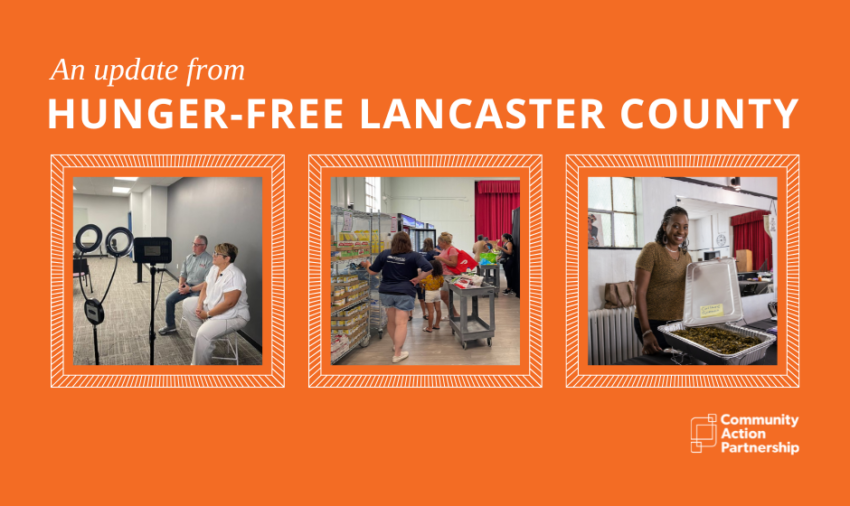Update: Hunger-Free Lancaster County

As the chair of the board of Hunger-Free Lancaster County and chair of its Path to Prosperity action team, respectively, CAP CEO Vanessa Philbert and CAP VP of Health and Nutrition Julie Rhoads recently shared an update with the community through an op-ed with Lancaster Online. Read on below for an update on the work to eliminate food insecurity in Lancaster County!
It’s been just over a year since the Central Pennsylvania Food Bank and Hunger-Free Lancaster County published their comprehensive report of findings from the yearlong Lancaster County Hunger Mapping Project. The report dives deeply into the root of food insecurity across our community, explores the charitable food system as the lowest-barrier resource for folks experiencing food insecurity, and makes recommendations for how we move forward to ensure everyone in our community has access to the nutrition they need for their family to thrive.
At Community Action Partnership of Lancaster County, we’re feeling inspired by this work and aligned in our place within it. We were an original member of Hunger-Free Lancaster County, a coalition of about 30 sector-diverse organizations throughout the county dedicated to eliminating food insecurity for Lancaster County residents. Leaning on our expertise as the county-contracted program distributing food to about 40 food pantries across Lancaster County, Community Action Partnership has stepped into a leadership role as the backbone agency of Hunger-Free Lancaster County.
This report from the Hunger Mapping Project is a road map, and we’re proud of the strides made in the short year since its findings were published:
- Hunger-Free Lancaster County debuted a new strategic plan to organize its efforts. The coalition and its partners will carry out project recommendations, guided by three action teams made up of folks from coalition organizations, further continuing community collaboration. Project recommendations will then be led by coalition organizations based on their particular expertise related to the work.
- The coalition developed a virtual volunteer training that will be free and accessible for all food pantries. The training will equip both food pantries and their volunteers with the knowledge they need to ensure that they create an equitable environment where every neighbor feels seen and welcome.
- The coalition will be hosting SNAP Blitz Days at four food pantries located in county priority areas identified in the report: two in Lancaster city, one in Columbia, and one in Quarryville. One of the findings in the report is the underutilization of government food assistance programs such as the Supplemental Nutrition Assistance Program. Only about 50% of visitors to food pantries participate in that federal program, while at least 85% are likely eligible. On SNAP Blitz Days, people can visit one of the four food pantries to see if they’re eligible for the Supplemental Nutrition Assistance Program and find support in signing up. We see this, too, as an upstream effort, knowing that food banks cannot be relied on as the only way to ensure families have access to the food they need.
- Hunger-Free Lancaster County will host a community convening. Partners, new and old, from across the county will be able to join us in learning more about ending hunger in Lancaster County and how to be part of the movement.
- At Community Action Partnership, we’ve hired a director of food justice, whose expertise and efforts are focused on developing and implementing innovative initiatives that increase access to nutritious food for every Lancaster County resident. Food justice is the idea that every person, no matter their income or personage, has equitable access to nutritious food that will support their health and well-being, and that it is vital for communities to work to remove barriers to that access.
- The food pantry at Crispus Attucks Community Center in southeast Lancaster city (a Community Action Partnership program) transitioned from a traditional food pantry with prepackaged boxes to a participant-choice model. This model honors participant autonomy and dignity, recognizes that not all families and diets are the same, and works to create equity in a space that has historically been and continues to see inequities.
We know, too, that many of our Hunger-Free Lancaster County partners across the county are busy evolving their work. We see folks keeping their food pantry doors open longer, raising dollars to increase their capacity to serve the community, and so much more.
During the Hunger Mapping Project, neighbors shared their experiences with the research team, and their words were powerful. One neighbor shared, “I’m just thankful that there are spaces that can help and supplement. It is appreciated.” Being vulnerable is never easy, but every day, we hear the voices of our neighbors speaking their truth and informing the work of Hunger-Free Lancaster County and its community partners.
This is just the beginning, and we’re all here for it. And we invite you to join us in this work – whether as a volunteer at your local food pantry, a donor to an organization in your community that walks alongside people experiencing food insecurity, an advocate who studies the findings in the Hunger Mapping Project and shares ideas with local leadership, or in another role that moves the work forward. Together, we can create a Lancaster County where no one goes hungry and everyone thrives.


